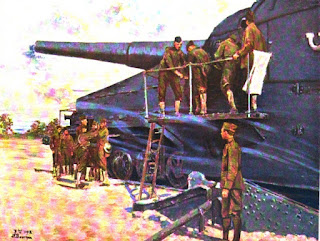I've come across this outstanding pictorial book from the First World War. It's titled: The American Army in France (1917–1919). It features watercolors and black-and-white drawings by French artist Joseph-Félix Bouchor with text by Captain David Gray, U.S. Army, and an introduction by none other than Lieutenant-Colonel Theodore Roosevelt.
One of the daily features of life at AEF General Headquarters at Chaumont was the midday concert of the band in the great quadrangle at Damremont Barracks. Aside from the presence of hundreds of officers and men in uniform, there was little in the daily life suggestive of war. . .
Just before moving into sector on the Chemin des Dames in February 1918, General Clarench Edwards of the 26th Yankee Division reviewed his division. He used the opportunity to give his men an explanation of the theory and practice of the military salute.
General Charles Mangin is, for many reasons, a figure of special interest to Americans. . . During the war he commanded three of our best divisions in some of their hardest fighting. The 1st and 2nd were in the Tenth Army on 18 July 1918 [for the Battle of Soissons], and the 32nd Division was with him in August when he stormed the heights of the Aisne.
Fourteen-inch Naval Gun, south of Soissons, which bombarded railways and roads north of Laon, 32 kilometers distant.







Amazing post. Thanks for sharing.
ReplyDelete